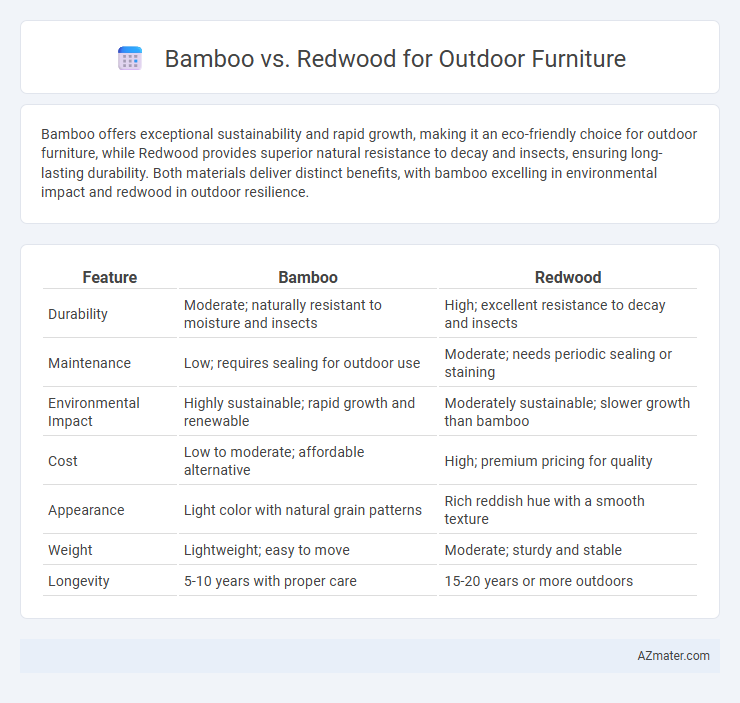Bamboo offers exceptional sustainability and rapid growth, making it an eco-friendly choice for outdoor furniture, while Redwood provides superior natural resistance to decay and insects, ensuring long-lasting durability. Both materials deliver distinct benefits, with bamboo excelling in environmental impact and redwood in outdoor resilience.
Table of Comparison
| Feature | Bamboo | Redwood |
|---|---|---|
| Durability | Moderate; naturally resistant to moisture and insects | High; excellent resistance to decay and insects |
| Maintenance | Low; requires sealing for outdoor use | Moderate; needs periodic sealing or staining |
| Environmental Impact | Highly sustainable; rapid growth and renewable | Moderately sustainable; slower growth than bamboo |
| Cost | Low to moderate; affordable alternative | High; premium pricing for quality |
| Appearance | Light color with natural grain patterns | Rich reddish hue with a smooth texture |
| Weight | Lightweight; easy to move | Moderate; sturdy and stable |
| Longevity | 5-10 years with proper care | 15-20 years or more outdoors |
Introduction to Bamboo and Redwood in Outdoor Furniture
Bamboo and redwood are popular choices for outdoor furniture due to their durability and natural resistance to moisture. Bamboo is a fast-growing grass known for its lightweight strength and eco-friendly properties, making it ideal for sustainable outdoor designs. Redwood, a softwood rich in tannins, offers exceptional weather resistance and a rich, warm color that enhances the aesthetic appeal of patio sets and garden benches.
Key Characteristics of Bamboo
Bamboo is a highly sustainable material known for its rapid growth and renewability, making it an eco-friendly choice for outdoor furniture. Its natural flexibility and strength provide excellent durability and resistance to cracking or warping under varying weather conditions. Bamboo's lightweight structure allows for easy maneuverability, while its natural antibacterial properties help it resist mold and pests in outdoor environments.
Key Characteristics of Redwood
Redwood is known for its natural resistance to decay and insects, making it ideal for outdoor furniture exposed to various weather conditions. Its rich reddish hue and tight grain offer both aesthetic appeal and durability. Redwood's stability prevents warping and cracking, ensuring long-lasting structural integrity in outdoor environments.
Durability Comparison: Bamboo vs Redwood
Bamboo offers impressive durability for outdoor furniture due to its natural resistance to moisture, insects, and rot, often rivaling hardwoods in strength and longevity. Redwood is renowned for its exceptional decay resistance, natural oils that protect against insects and fungal growth, and ability to withstand harsh weather conditions, making it a top choice for outdoor applications. While bamboo tends to require sealing and regular maintenance to preserve its lifespan, redwood generally endures longer with minimal upkeep, especially in wet or humid environments.
Weather Resistance and Longevity
Bamboo offers exceptional weather resistance due to its natural oils and dense fiber structure, making it highly resistant to moisture, insects, and warping, ideal for outdoor furniture in humid or rainy climates. Redwood contains natural tannins that provide strong protection against decay, rot, and insect attacks, contributing to its long lifespan even in exposed outdoor environments. While bamboo typically requires regular sealing to maintain durability, redwood's inherent resistance often results in greater longevity and less maintenance over time.
Sustainability and Environmental Impact
Bamboo, a fast-growing grass, offers exceptional sustainability as it regenerates quickly without the need for replanting, absorbing high levels of CO2 and producing more oxygen than many tree species. Redwood, although durable and naturally resistant to decay, grows much more slowly, resulting in a higher environmental footprint due to longer harvesting cycles and potential habitat disruption. Choosing bamboo furniture significantly reduces carbon emissions and deforestation effects, making it a more eco-friendly option for outdoor use.
Maintenance Requirements for Each Wood
Bamboo outdoor furniture requires regular sealing and oiling to maintain its moisture resistance and prevent cracking or splitting, especially in humid or rainy climates. Redwood furniture naturally resists decay, insects, and warping due to its high tannin content, reducing the need for frequent treatments, but occasional cleaning and sealing can extend its lifespan and appearance. Both materials benefit from periodic inspection to address any surface damage, though bamboo demands more proactive maintenance to retain durability in outdoor settings.
Aesthetic Appeal and Design Versatility
Bamboo offers a sleek, modern aesthetic with its smooth texture and light golden hue, complementing contemporary outdoor spaces and minimalist designs. Redwood features rich reddish tones and natural grain patterns, delivering a warm, rustic elegance highly valued in traditional or craftsman-style settings. Both materials provide design versatility, with bamboo suited for intricate weaving and innovative shapes, while redwood excels in sturdy, classic furniture designs adaptable to various outdoor environments.
Cost Analysis: Bamboo vs Redwood
Bamboo outdoor furniture typically costs between $200 and $600 per set, offering an affordable, sustainable option with rapid renewability and lower maintenance expenses compared to redwood. Redwood furniture ranges from $500 to $1,200 due to its durability, natural resistance to decay, and premium aesthetic appeal, but it demands periodic sealing to prevent weather damage. Choosing between bamboo and redwood hinges on balancing upfront affordability with long-term durability and upkeep costs.
Choosing the Right Material for Your Outdoor Space
Bamboo offers exceptional durability, natural resistance to moisture, and rapid renewability, making it an eco-friendly choice for outdoor furniture in humid climates. Redwood features inherent resistance to decay and insects, providing long-lasting performance and a rich, warm aesthetic ideal for shaded or drier environments. Selecting between bamboo and redwood depends on factors such as climate conditions, maintenance preferences, and desired furniture longevity to optimize outdoor space functionality and style.

Infographic: Bamboo vs Redwood for Outdoor Furniture
 azmater.com
azmater.com